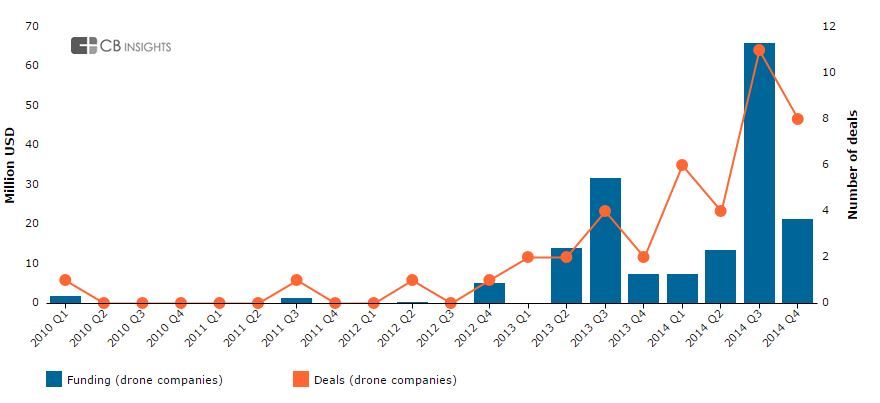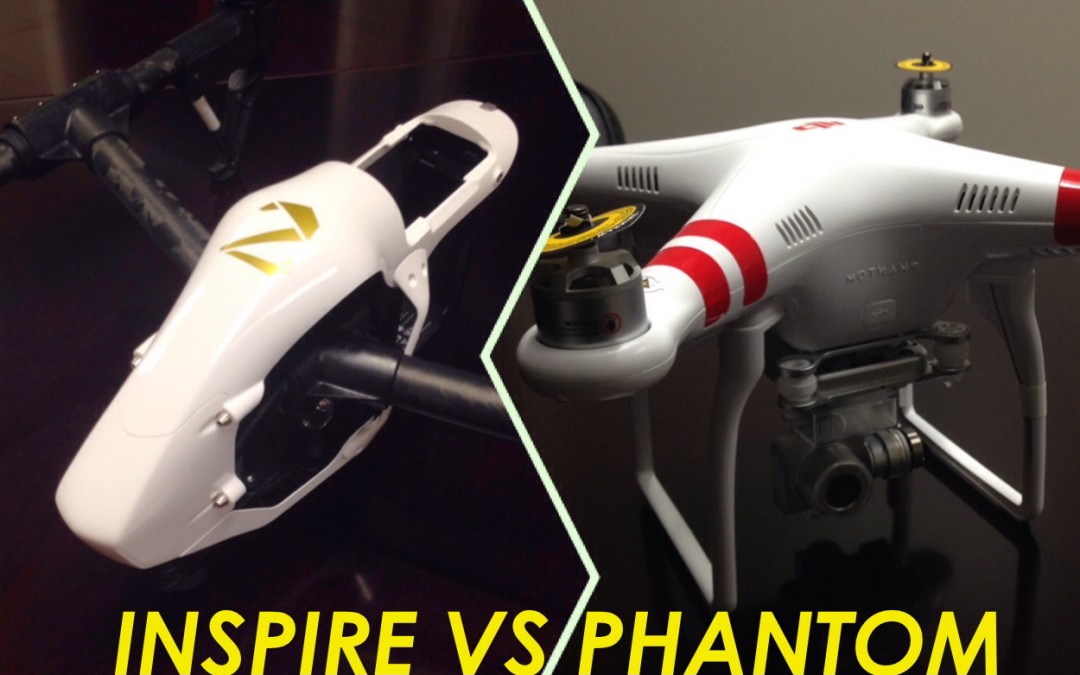Five years ago, if someone said the word “drone,” you’d probably conjure up the image in your head of a strange robotic copter flying through the air, programmed for special military purposes. But now, drones have exploded in the consumer’s world. In fact, this year, DJI drones, one of the world’s most popular manufacturers of consumer level drones, has announced that its expected to hit the $1 Billion mark by the end of this year. That’s up from $500 million in 2014, which had quadrupled from the year previously.
Here at the headquarters of Powered Labs, we have two editions of the DJI drone models, the DJI Inspire 1 and the DJ Phantom Vision 2+. We’re kind of nerds for anything video-and-technology related, so we’ve made the investment into these two models for various reasons. Before we get into the details of each of the drones, the first observation is that they both have a premium look, feel and construction to them. In fact, these models are the perfect stepping stones for people who are passionate about film, who want to be able to take professional shots, but don’t quite require the next echelon of professional drones which are close to ten times the cost.

These are both powerful, and accessible to people. The more basic Phantom version of these drones have been dubbed by some as “the kleenex of drones” because they’d almost become a household name.
We first acquired the DJ Inspire 1 in January of this year. If you haven’t already, check out the
cool video we created right after it was originally unboxed.
Weighing in at just around 5 pounds, this drone can ascend into the skies at 5 meters per second, has a maximum fly altitude of 4500 meters, and manages a top speed of 50 miles per hour. It features automatic take off and landing, where the legs of the drone move accordingly to accommodate the camera which rotates 360 degrees below the unit.
Especially impressive is the 4K quality and ISO range (between 100-3200 for video) on the camera itself. While that means you have to invest in a different class of memory cards to record your footage onto, the quality we saw was just unbelievable, and looks not too different to something that could be achieved with a very expensive crane shot.
Let’s turn to the the DJI Phantom Vision 2+, which we acquired just this week. This drone model is a step down from the Inspire, and is about half the cost.

Now for some specs. The Vision model is significantly lighter, less than half the weight, and as a result can fly up to 25 minutes, as compared to the 18 minute max on the Inspire. The camera shoots full HD at 1080 and 30 fps, and is equipped with a 14 MP camera.
Both drones are fantastic and after using them to explore our surroundings we are in love with them. Both are operated by powerful handheld remote controls which you can hook up to your smartphone to stream and view the footage that the camera is collecting from the skies.
At the same time, there is a growing list of rules in place about how and where to operate your drone. Even if you can see where your drone is from your phone, if it’s prohibited to fly your drone beyond your line of sight, higher than 500 feet or within 5 miles of an airport.
Drones like these have revolutionized how we are going to be able to not only express ourselves creatively, but also for journalistic purposes. A reporter in the field can capture footage of an event where it’s not possible to on foot. Imagine filming a revolution from above the streets where people are rioting, giving a never-seen-before look at what a revolution looks like. But, the rules of journalism still apply in what you can report, because there’s a thin line between that and surveillance, which is a big proponent against consumer drones. According the Professional Society of Drone Journalists, journalists can only use drones if there are
no other means of investigating a story, staying true to traditional journalism ethics. Airspace is federal, and so we’ll be watching more closely in the months and years to come to see how drone videography will be expanding to other sectors.
The truth is that the purpose of this technology, like any other technology, is up to the person using it. Be responsible, and be ethical!
 These are both powerful, and accessible to people. The more basic Phantom version of these drones have been dubbed by some as “the kleenex of drones” because they’d almost become a household name.
We first acquired the DJ Inspire 1 in January of this year. If you haven’t already, check out the cool video we created right after it was originally unboxed.
Weighing in at just around 5 pounds, this drone can ascend into the skies at 5 meters per second, has a maximum fly altitude of 4500 meters, and manages a top speed of 50 miles per hour. It features automatic take off and landing, where the legs of the drone move accordingly to accommodate the camera which rotates 360 degrees below the unit.
Especially impressive is the 4K quality and ISO range (between 100-3200 for video) on the camera itself. While that means you have to invest in a different class of memory cards to record your footage onto, the quality we saw was just unbelievable, and looks not too different to something that could be achieved with a very expensive crane shot.
Let’s turn to the the DJI Phantom Vision 2+, which we acquired just this week. This drone model is a step down from the Inspire, and is about half the cost.
These are both powerful, and accessible to people. The more basic Phantom version of these drones have been dubbed by some as “the kleenex of drones” because they’d almost become a household name.
We first acquired the DJ Inspire 1 in January of this year. If you haven’t already, check out the cool video we created right after it was originally unboxed.
Weighing in at just around 5 pounds, this drone can ascend into the skies at 5 meters per second, has a maximum fly altitude of 4500 meters, and manages a top speed of 50 miles per hour. It features automatic take off and landing, where the legs of the drone move accordingly to accommodate the camera which rotates 360 degrees below the unit.
Especially impressive is the 4K quality and ISO range (between 100-3200 for video) on the camera itself. While that means you have to invest in a different class of memory cards to record your footage onto, the quality we saw was just unbelievable, and looks not too different to something that could be achieved with a very expensive crane shot.
Let’s turn to the the DJI Phantom Vision 2+, which we acquired just this week. This drone model is a step down from the Inspire, and is about half the cost.
 Now for some specs. The Vision model is significantly lighter, less than half the weight, and as a result can fly up to 25 minutes, as compared to the 18 minute max on the Inspire. The camera shoots full HD at 1080 and 30 fps, and is equipped with a 14 MP camera.
Both drones are fantastic and after using them to explore our surroundings we are in love with them. Both are operated by powerful handheld remote controls which you can hook up to your smartphone to stream and view the footage that the camera is collecting from the skies.
At the same time, there is a growing list of rules in place about how and where to operate your drone. Even if you can see where your drone is from your phone, if it’s prohibited to fly your drone beyond your line of sight, higher than 500 feet or within 5 miles of an airport.
Drones like these have revolutionized how we are going to be able to not only express ourselves creatively, but also for journalistic purposes. A reporter in the field can capture footage of an event where it’s not possible to on foot. Imagine filming a revolution from above the streets where people are rioting, giving a never-seen-before look at what a revolution looks like. But, the rules of journalism still apply in what you can report, because there’s a thin line between that and surveillance, which is a big proponent against consumer drones. According the Professional Society of Drone Journalists, journalists can only use drones if there are no other means of investigating a story, staying true to traditional journalism ethics. Airspace is federal, and so we’ll be watching more closely in the months and years to come to see how drone videography will be expanding to other sectors.
The truth is that the purpose of this technology, like any other technology, is up to the person using it. Be responsible, and be ethical!
Now for some specs. The Vision model is significantly lighter, less than half the weight, and as a result can fly up to 25 minutes, as compared to the 18 minute max on the Inspire. The camera shoots full HD at 1080 and 30 fps, and is equipped with a 14 MP camera.
Both drones are fantastic and after using them to explore our surroundings we are in love with them. Both are operated by powerful handheld remote controls which you can hook up to your smartphone to stream and view the footage that the camera is collecting from the skies.
At the same time, there is a growing list of rules in place about how and where to operate your drone. Even if you can see where your drone is from your phone, if it’s prohibited to fly your drone beyond your line of sight, higher than 500 feet or within 5 miles of an airport.
Drones like these have revolutionized how we are going to be able to not only express ourselves creatively, but also for journalistic purposes. A reporter in the field can capture footage of an event where it’s not possible to on foot. Imagine filming a revolution from above the streets where people are rioting, giving a never-seen-before look at what a revolution looks like. But, the rules of journalism still apply in what you can report, because there’s a thin line between that and surveillance, which is a big proponent against consumer drones. According the Professional Society of Drone Journalists, journalists can only use drones if there are no other means of investigating a story, staying true to traditional journalism ethics. Airspace is federal, and so we’ll be watching more closely in the months and years to come to see how drone videography will be expanding to other sectors.
The truth is that the purpose of this technology, like any other technology, is up to the person using it. Be responsible, and be ethical!

